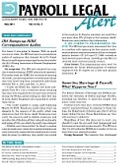Uncle Sam has released new cost-of-living adjustments affecting Social Security tax withholding and retirement plans for 2014.
Social Security wage base
The Social Security Administration has announced that the 2014 taxable wage base for the Social Security portion of FICA increases to $117,000. That’s a 2.9% hike over the 2013 wage base of $113,700.
The 6.2% Social Security tax is payable by both employers and employees; in 2014, the maximum tax is $7,254. Except for pretax medical and tax-free fringe benefits, all wages are subject to the 1.45% Medicare portion of FICA, or the 2.35% Medicare portion of FICA for employees earning more than $200,000, since there’s no wage base. (SSA Fact Sheet, 10-30-13)
Exempt amounts for retirees. Retirees who want to return to work are a reliable resource, since they already know the ropes. However, they may lose some of their Social Security benefits. How much they’ll lose depends on an earnings test. Tip: Retirees usually think they’ll lose more benefits than they actually will, so informing them of the 2014 figures can ease their minds.
Retirees who return to work during the year they reach full retirement age—between 65 and 67, depending on when they were born—are subject to a modified earnings test that applies only to earnings for the months before that birthday. Wages earned after that birthday don’t reduce Social Security benefits. For 2014, the exempt amount is $41,400 a year; $3,450 a month. For them, $1 in benefits is lost for every $3 they earn.
A separate earnings test applies to early retirees. Employees who retire before they reach full retirement age and who then return to work, can earn up to $15,480 a year, or $1,290 a month, without losing benefits. For these retirees, $1 in benefits is lost for every $2 they earn.
2014 Pension COLAS
The amount employees can contribution into their 401(k) or 403(b) plan accounts remains $17,500 for 2014, the IRS has announced.
In addition, employees who are at least 50 years old in 2014 may continue to make $5,500 in pretax catch-up contributions.
Other inflation-adjusted amounts for qualified pension plans include the following:
- The Section 415 limit (i.e., the overall pretax, after tax and employer contribution) increases $1,000, to 100% of compensation or $52,000
- The annual compensation limit (i.e., the limit above which contributions can no longer be taken into account increases $5,000, to $260,000
- The dollar limitation concerning the definition of key employee in a top-heavy plan is increases $5,000, to $170,000
- The dollar limitation used in the definition of a highly compensated employee remains $115,000.
The IRS also announced 2014 inflation-adjustments for other qualified benefits.
- The credit phase-out for small employers that provide health insurance to employees and that pick up at least 50% of the premium cost increases $400, to $25,400
- The maximum that employees can contribute on a pretax basis into cafeteria plan health flexible spending accounts remains $2,500
- The maximum monthly tax-free reimbursement for qualified employer parking increases $5, to $250
- The maximum monthly tax-free qualified mass transit fringe decreases $115, to $130. Note: This year, there was parity between qualified parking and mass transit fringes. The substantial decrease in mass transit fringes reflects the expiration of parity. It will be up to Congress to extend parity again.

